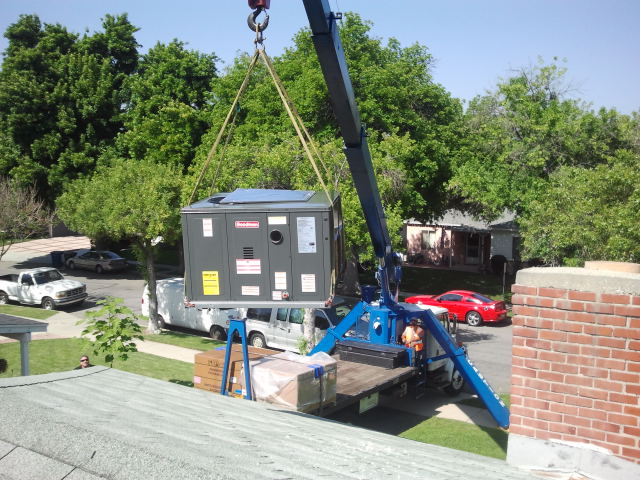
The process of installing an air conditioning (AC) package unit onto a rooftop involves several critical steps and considerations to ensure the unit is installed safely, efficiently, and effectively. The use of a crane to lift the unit onto the roof is a common practice, especially for large, commercial AC units that are too heavy to be manually lifted. Here’s a detailed look into this process:
Lifting the AC Package Unit
- Preparation: Before lifting, technicians ensure that the AC package unit is properly secured and balanced for lifting. This often involves attaching slings or straps to designated points on the unit to ensure a stable lift.
- Crane Use: A crane is carefully positioned and used to lift the AC unit from the ground to the rooftop. The crane’s capacity must exceed the weight of the AC unit to safely complete the lift. Crane operators and ground personnel communicate closely during this operation to ensure safety and precision.
Roof Curb Installation
- Function of the Roof Curb: The roof curb serves multiple critical functions. It’s not just a platform; it’s a specially designed support structure that bears the weight of the AC unit, ensuring it is securely mounted on the roof. Additionally, the curb facilitates the integration of the AC unit with the building’s ductwork system.
- Construction and Design: Typically made from galvanized sheet metal, roof curbs are designed to withstand the outdoor elements and the significant weight of the AC units they support. They are custom-fabricated to match the footprint of the AC unit, ensuring a proper fit.
- Air Duct Penetration: The roof curb is engineered to provide a seamless transition for air ducts through the roof, allowing for efficient air flow from the AC unit into the building’s interior spaces. This is crucial for the “down shot” installation, where the air is distributed downward into the building.
- Sealing and Insulation: Proper sealing and insulation around the roof curb are essential to prevent water leakage and to maintain energy efficiency. The curb is sealed to the roof to prevent water ingress, and the duct connections are insulated to prevent energy loss.
Installation Considerations
- Weather and Environmental Factors: The installation process must consider weather conditions, as lifting operations can be hazardous in high winds or inclement weather. Additionally, the positioning of the AC unit and curb must account for water drainage and roof load-bearing capacity.
- Compliance and Standards: The installation must comply with local building codes, regulations, and industry standards, ensuring that the unit is installed safely and operates efficiently.
- Coordination with Roofing Contractors: Often, the installation of a roof curb requires coordination with roofing contractors to ensure the integrity of the roof is maintained and that the installation does not compromise the roof’s warranty or performance.
